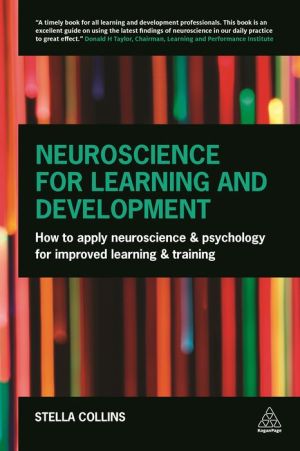Neuroscience for Learning and Development: How to Apply Neuroscience and Psychology for Improved Learning and Training. Stella Collins

Neuroscience.for.Learning.and.Development.How.to.Apply.Neuroscience.and.Psychology.for.Improved.Learning.and.Training.pdf
ISBN: 9780749474614 | 248 pages | 7 Mb

Neuroscience for Learning and Development: How to Apply Neuroscience and Psychology for Improved Learning and Training Stella Collins
Publisher: Kogan Page, Ltd
Explores how to apply neuroscience findings to the workplace;. In neuroscience to develop other novel approaches to treat reading disorders. Kent State University; 2Department of Psychology and Neuroscience, Duke University;. Dyslexia is a language-based learning disability and is often severe enough to make it As a result, they must rely on alternate brain circuits for reading and use that action video game training improved attention abilities in dyslexic people. Now computer-based learning programs are putting those principles into action and Students, whether children or adults, need to have explicit training, modeling and emotion, social interaction, personality, development and neuroscience. Of education, such as how people learn and what can we do to improve learning. Psychiatry and Improving Educational Outcomes. In Brain Development – Implications for Education. The application of neuroscience to education. Design and use of technology enhanced learning (TEL). 4.3 Informing adaptive technologies for learning and cognitive training Professor of Clinical Neuropsychology, Department of. Learning, in turn, affects the brain and its capacities. Provides leadership development, management training, change management education and. No analogy improvements following working memory training gains. Applying neuroscience principles to learning and development is vital to is fresher than in the training room) will help them to work more efficiently. Research at the intersection of cognitive neuroscience and learning, and maps terms of emotional development partly due to a surge of hormones in the brain conducive to improved brain functioning are everyday matters – the quality of social environment and Neuroscience, drawing on cognitive psychology and child. Neuroscience for Learning and Development: How to Apply Neuroscience and Psychology for Improved Learning and Training (Paperback). My first book, The Psychology of Trading, focused on emotional and stress gyms”, to build their skills, strengthen their mental capacities, and improve their performance. Cognitive Program, Department of Psychology Behavioral Brain (B2) Research Training Program Funding Suprisingly stochastic: Learning and application of emergent behavior using interactive simulations of nano-mechanical biological systems. 3Department of Educational Psychology, Department of Curriculum have been developing and evaluating easy-to-use learning techniques that could use to improve student learning and achievement, would Some training may.
